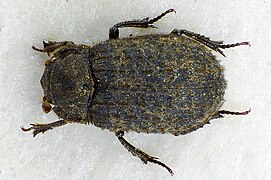
Trogidae, sometimes called hide beetles, is a family of beetles with a distinctive warty or bumpy appearance. Found worldwide, the family includes about 300 species contained in four or five genera.
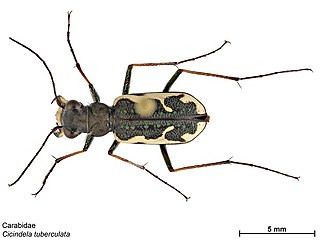
Neocicindela tuberculata is a species of tiger beetle in the family Cicindelidae, endemic to New Zealand. Its common names include common tiger beetle, moeone, and papapa, and in its laval stage penny doctor, butcher boy, kapuku, kui, kurikuri, moeone, and muremure. Neocicindela tuberculata was the first carabid beetle described from New Zealand. The species can run as fast as 5 miles per hour and are considered to be the fastest running beetles. Adult species prefer clay banks in summer and are good predators when in comes to insects.

Tyrannasorus rex is an extinct species of hybosorid beetle known to exist in the Miocene epoch and the sole member of the monotypic genus Tyrannasorus. A fossilized example scarabaeoid was found embedded in the amber resin of Hymenaea protera in the Dominican Republic. The species was described by Brett C. Ratcliffe and Federico Carlos Ocampo in 2001.
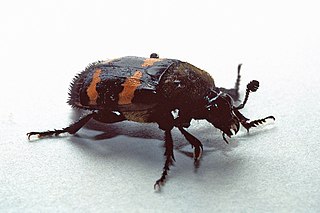
Nicrophorus tomentosus is a species of burying beetle that was described by Friedrich Weber in 1801. The beetle belongs to the family Silphidae which are carrion beetles. The beetles have sensitive antennae that contain olfactory organs. Thus, the beetle can locate dead animals (carcass), and then as the name suggests, can bury them. However, unlike other burying beetles, N. tomentosus does not completely bury these brood carcasses. They instead dig a shallow hole under the carcass and cover it with leaf litter. Recognition of these beetles can be distinguished by its black color with orange markings on the wing covers (elytra).

Xylocleptes bispinus is a snout beetle from the subfamily of Scolytinae. It builds its nests in the bark of clematis shrubs.

Adalia decempunctata, the ten-spotted ladybird or ten-spotted lady beetle, is a carnivorous beetle of the family Coccinellidae.

Callipogon relictus is a species of longhorn beetle which is mostly found in Korea, but also in China and southern part of Russian Far East. It inhabits mixed and deciduous forests. The population of Callipogon relictus is decreasing due to deforestation and uncontrolled collection, and therefore the species are listed in the Russian Red Book.

Clytra laeviuscula, the ant bag beetle, is a species of short-horned leaf beetles belonging to the family Chrysomelidae, subfamily Cryptocephalinae.

Exosoma lusitanicum or daffodil leaf beetle is a species of skeletonizing leaf beetles belonging to the family Chrysomelidae, subfamily Galerucinae.

Lachnaia italica is a species of short-horned leaf beetles belonging to the family Chrysomelidae, subfamily Clytrinae.

Oenopia conglobata is a species of ladybird (Coccinellidae) native to continental Europe, Asia and Africa. Its colloquial names in Germany are 'poplar ladybird' and Kugelige ladybird.

Aphidecta obliterata is a species of Coccinellidae, a flying beetle.

Phaleria is a genus of darkling beetles belonging to the family Tenebrionidae.
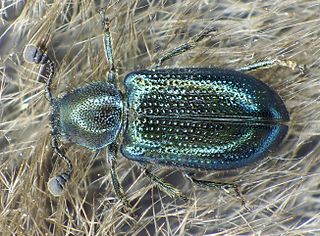
Necrobia violacea is a species of beetle in family Cleridae. Cleridae beetles are a predaceous beetle found within forest and woodland environments, and can be associated with stored food products as both pests and predators of other insects.

Tillus elongatus is a species of beetle in the Family of checkered beetles Cleridae. It is found in the Palearctic. The “Holz” in the German common name Holzbuntkäfer indicates that these checkered beetles are found in wood. Although Tillus elongatus can reach up to a size of 1 cm long, the beetle is rarely seen by humans, as it primarily resides hidden in the wood of trees. The colouration of the males differs from that of the females.

Bodiloides ictericus is a species of dung beetle in the family Scarabaeidae, found in the Palearctic. It is one of more than 50 species in the genus Bodiloides.
Chrysanthia superba is a species of false blister beetles belonging to the family Oedemeridae.
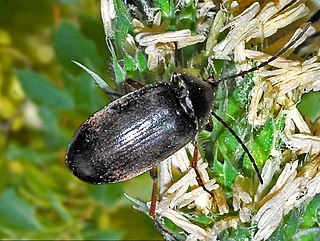
Isomira hypocrita is a species of comb-clawed beetles belonging to the family Tenebrionidae subfamily Alleculinae.

Coptocephala unifasciata is a species of leaf beetle belonging to the family Chrysomelidae, subfamily Cryptocephalinae.
Batrisus formicarius is a European species of ant-loving beetle placed within the Pselaphinae subfamily of the Staphylinidae family.


